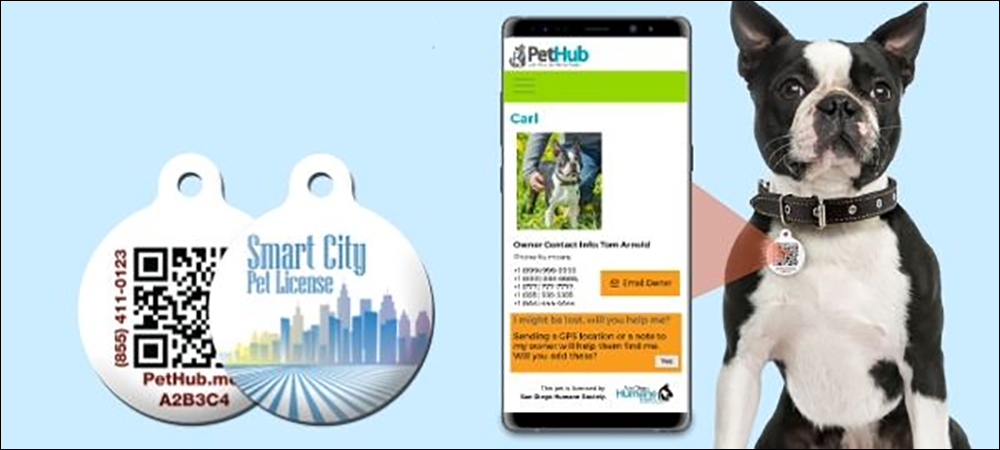PetHub, a Washington State-based technology company, has announced that a pet’s identity and profile can be stored in the cloud, tag and developed a server-based solution. This data can then be accessed by scanning a QR code on the animal’s tag or, finally, by embedded in Accessible by touching the >Near Field Communication (NFC) tag. ISO 14443 using 13.56 MHz chip, NFC function, dog It is increasingly used by businesses where larger volumes of pets are managed, such as nursing homes and bars.

The first thing most people do when they find an unaccompanied pet is to look at the collar tag, which is typically stamped with the pet’s owner’s name and phone number. Lorien Clemens, CEO of the company, says that since the launch of the PetHub tag, the front-printed QR code containing the PetHub app has made it possible for individuals to view much more data about the animal on their phones.
Users first create their online profile, which includes information such as their pet’s name, breed, age, medications and allergies, and multiple emergency contacts. they would pay monthly or yearly for the pet or a pet family. A good Samaritan who finds a lost pet can simply access the tag and use his phone QR to view information such as how best to return the pet to its owner. can keep it in front of your code.
There are now 3.5 million PetHub digital IDs in circulation, says Clemens, and between 700 and 1,000 new pets join the site every day. Many use the QR code tag, but new tags allow people to access data faster. and NFC to enable them to handle an animal and its collar less. The company first established its animal identification platform in 2010, then filed a patent for the use of NFC technology in 2012. However, Clemens remembers that the limited availability of NFC on smartphones, particularly iOS devices, means that the use of the functionality is limited.
The company has also researched other wireless technologies such as Bluetooth, but has found that Bluetooth transmissions are less reliable. Clemens explains that the signal between the tag and the smartphone is often lost even when a tag is near a phone. “The dog may be around the corner,” he says. the system will tell you that the dog is out of range.” In addition, some Bluetooth tracking systems, such as Tile and Apple AirTag, tend to require an app to be open for operation. The company has stated that Bluetooth technology will not serve the app appropriately.
Clemens added that the QR code is still the most widely used technology on the label, and the COVID-19 outbreak has made consumers more comfortable with scanning such codes. For example, many restaurants now have QR code-based menus and orders. “It’s a very successful technology for us,” he says.
According to Clemens, 96 percent of lost pets are returned within 24 hours or less. NFC brings new value to situations where scanning QR codes is not possible. it requires people to reach under a dog’s muzzle and lift the tag up to scan it. You have dog wiggle syndrome,” he says, which makes QR code scans difficult. is an application.
“There are a lot of really exciting applications out there,” says Clemens. can hold a phone and see not only the pet’s identity, but also other important information such as whether the animal is up to date with its footage. Moreover, technology can verify that an animal has undergone specific behavioral training. The data collected can be customized for each business.
According to Clemens, PetHub’s customers are primarily pet parents who visit the company’s website to meet the needs of a daycare business or through referrals from animal shelters, animal control departments, municipal governments or pet insurance companies. they can directly purchase a PetHub kit that includes NFC and QR tags to attach to a pet’s collar, an NFC and QR code card for a travel crate, and a key fob card that can access pet information in any situation. the owner becomes incapacitated. The travel chest card is reinforced with plastic and is attached to the chest to allow airport personnel or other people to access the identity information without opening it.
PetHub software allows pet owners to report a missing dog and cat, which prompts the company to alert local shelters. The company can also notify friends and family members of a pet’s “safety circle” if a pet goes missing, and automatically update them when the missing pet is found.
